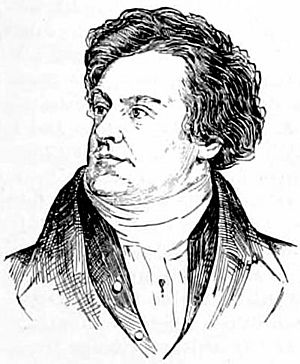William Leete Stone Sr. facts for kids
Quick facts for kids
William Leete Stone
|
|
|---|---|
 |
|
| Signature | |
William Leete Stone, often called Colonel Stone, was an important journalist, writer, and public official in New York City. He was born in New Paltz, New York (or Esopus, New York) in 1792 or 1793 and passed away in Saratoga Springs, New York in 1844. His name sometimes appears as "Leet".
Contents
Biography
Early Life and Start in Journalism
William Leete Stone's father, also named William, was a soldier during the American Revolution. Later, he became a clergyman. William Leete Stone moved to Sodus, New York in 1808. He helped his father on their farm. This area was wild back then, and his experiences gave him ideas for stories he would write later.
When he was 17, he started working as a printer for a newspaper called the Federalist in Cooperstown, New York. By 1813, he became an editor for the American newspaper in Herkimer (town), New York. A famous journalist named Thurlow Weed worked for him there.
Later, Stone edited other newspapers like the Northern Whig in Hudson, New York and the Daily Advertiser in Albany, New York. In 1818, he became the editor of the Mirror in Hartford, Connecticut. While in Hartford, he helped edit a literary magazine called The Knights of the Round Table. He also edited The Lounger, a witty literary magazine, in Hudson.
A Career in Journalism
In 1821, William Leete Stone became the editor and one of the owners of the New York Commercial Advertiser newspaper. He worked there for the rest of his life. As editor, he was involved in a famous lawsuit with the novelist James Fenimore Cooper. This was because of criticisms of Cooper's books that appeared in Stone's newspaper.
Fighting for Change
Stone strongly supported ending slavery. He wrote about it in the Commercial Advertiser. He also supported the American Colonization Society. This group wanted to send freed slaves to Africa. He even became the President of the New York Colonization Society.
In 1825, at an anti-slavery meeting in Baltimore, he helped create a plan to free slaves. This plan suggested sending freed slaves out of the United States and paying slaveholders for their loss. This idea was suggested to the United States Congress. However, Stone was also a strong critic of groups like the American Anti-Slavery Society that wanted to end slavery immediately. He was seen by some as a cause of the Anti-abolitionist riots in 1834.
In 1824, Stone felt strongly about helping the Greeks in their fight for independence. With others like Edward Everett and Samuel Gridley Howe, he helped bring attention to their cause in the United States. In 1825, he traveled with the Marquis de Lafayette on a trip up the Hudson River. Lafayette was a French hero of the American Revolution who was touring the United States. Brown University gave Stone an honorary degree in 1825.
After William Morgan disappeared, there was a lot of talk about Freemasonry. Stone, who was a Freemason himself, wrote letters about "Masonry and Anti-Masonry" to John Quincy Adams. In these letters, which were later published, Stone argued that Freemasonry should be stopped because it was no longer useful.
Public Service and Later Life
Colonel Stone, as he was known, was very influential in New York City. He held the rank of Colonel on Governor DeWitt Clinton's staff. He was the first superintendent of public schools in New York City. In this role, he had a discussion with Archbishop John Hughes about whether the Bible should be used in public schools. He also worked hard to help religious groups and charities, especially those for the deaf and dumb and for young people who had gotten into trouble.
In 1838, he suggested that the New-York Historical Society ask the New York legislature to send a mission to England and the Netherlands. The goal was to find old papers and documents important to New York's colonial history. This led to the collection known as the New York Colonial Documents. Stone also helped clear up misunderstandings about Governor De Witt Clinton.
In 1841, President William Henry Harrison appointed Stone as a minister to the Hague in the Netherlands. However, he was later called back by President John Tyler.
Colonel Stone was also made a chief of the Seneca Nation of Native Americans. He gave talks at Union College about the dangers of using tobacco. He was also known for looking into the claims of a woman named Maria Monk.
Family
William Leete Stone was married to Susannah Wayland. She was the sister of Francis Wayland, who was the President of Brown University. Their only son, William Leete Stone Jr., also became a writer who focused on the American Revolution.
Works
- History of the Great Albany Constitutional Convention of 1821 (1822)
- Narrative of the Grand Erie Canal Celebration, written for the New York City Council (1825)
- Tales and Sketches: Such As They Are (2 volumes, 1834)
- The Witches: A Tale of New-England (1837); later republished as Mercy Disborough: A Tale of New England Witchcraft (1844)
- Border Wars of the American Revolution (2 volumes, 1843)
See also
- Robert Matthews (religious figure), known as Matthias the Prophet

